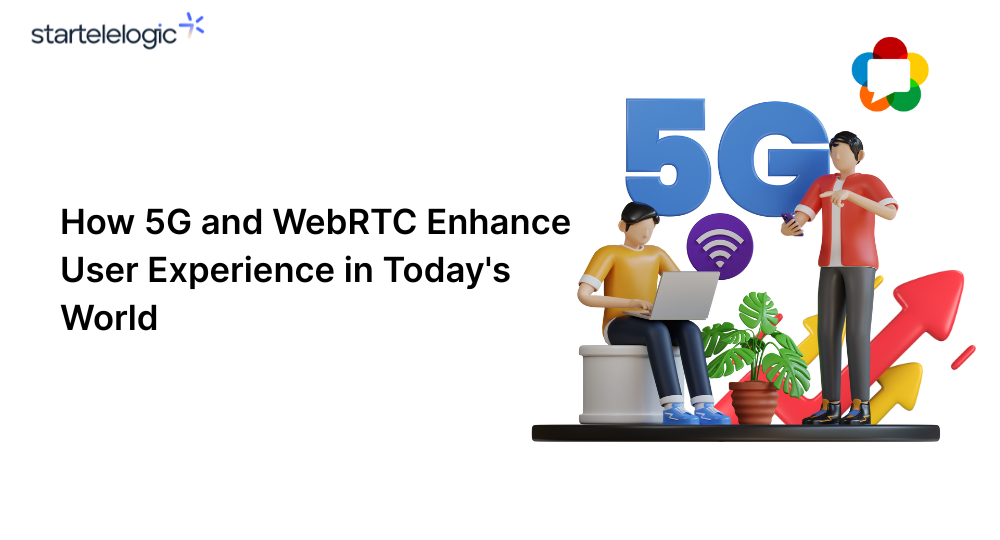Think about it, ever tried making a video call while riding in a moving car? Or joined a work meeting online only to deal with choppy video and delays? These days, you don’t have to settle for that. With 5G and WebRTC working together, clear calls and smooth virtual meetings are now possible, even on the go. It’s not science fiction, it’s happening right now. As we keep moving toward a more digital world, these two technologies are quietly changing how we connect, talk, and work together, in real time and without the frustration.
According to recent industry reports, the global 5G market is expected to reach over $1.8 trillion by 2030, with user subscriptions projected to surpass 4.4 billion by 2027. This rapid adoption is driven by the need for faster, more reliable mobile connectivity. On the other hand, WebRTC is now integrated into major platforms used by over 2 billion people worldwide every month, from video calls to online customer service. These figures highlight just how central 5G and WebRTC are becoming in powering the next generation of real-time digital communication.
What is 5G and WebRTC Technology?
5G is the fifth generation of wireless networks, offering faster speeds, lower latency, and more reliable connections. On the other hand, WebRTC (Web Real-Time Communication) is an open-source technology that allows audio, video, and data sharing directly between browsers without the need for plugins.
When combined, 5G and WebRTC technology deliver a seamless, high-quality real-time communication experience.
Benefits of 5G for Users
One of the biggest benefits of 5G for users is the ability to enjoy ultra-fast internet speeds. This means smoother video calls, quicker downloads, and more reliable streaming. For example, users can now join high-definition video meetings without any lag, even while on the go.
Another key advantage is the low latency of 5G. This ensures that real-time interactions, like online gaming or live broadcasting, feel more natural and responsive. Users no longer have to deal with delays or buffering.
WebRTC Communication: The Future of Real-Time Interaction
WebRTC communication allows people to connect instantly via video and voice, all within their web browsers. Whether you’re making a video call, sharing a screen, or sending a file, WebRTC makes it possible without third-party apps or software.
This real-time communication technology is already being used in popular platforms like Google Meet, Zoom, and WhatsApp. It provides a more secure and faster way to communicate, which is especially important in a world where remote work and virtual meetings are the norm.
How 5G Enhances WebRTC Communication
When paired with WebRTC communication, the 5G network advantages truly shine. The high bandwidth and low latency of 5G make WebRTC apps run more smoothly and efficiently. This means fewer dropped calls, better video quality, and more stable connections.
For businesses, this is a game-changer. Teams can collaborate from anywhere in the world in real time, with video and audio quality that rivals in-person meetings. For consumers, it means better experiences in gaming, live events, and online support.
Conclusion
5G and WebRTC technology are transforming the way we live, work, and connect. With the benefits of 5G for users and the power of real-time communication technology, we are entering a new era of digital interaction. As these technologies continue to evolve, they will unlock even more possibilities for seamless and instant communication across the globe.
FAQs about 5G and WebRTC Technology
1. What is 5G and WebRTC technology, and how do they work together?
5G and WebRTC technology combine the high-speed, low-latency power of 5G networks with the real-time communication capabilities of WebRTC. Together, they enable seamless voice, video, and data sharing across devices without the need for third-party apps or plugins.
2. How does 5G improve the performance of WebRTC communication?
5G enhances WebRTC communication by providing faster data transfer, ultra-low latency, and better reliability. This results in higher-quality video calls, reduced buffering, and more stable real-time connections—even in crowded or mobile environments.
3. What are the main benefits of 5G for users in real-time applications?
The key benefits of 5G for users include ultra-fast internet speeds, minimal lag, and improved connectivity. These features are especially useful for video conferencing, online gaming, remote work, and live streaming.
4. Where is 5G and WebRTC technology being used today?
5G and WebRTC technology are used in various industries, including telehealth, online education, customer support, gaming, and business collaboration tools like Zoom, Microsoft Teams, and Google Meet.
5. Is WebRTC secure when used over 5G networks?
Yes, WebRTC communication is built with end-to-end encryption, and when used on a secure 5G network, it offers a safe and private environment for real-time voice and video communication.




